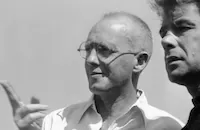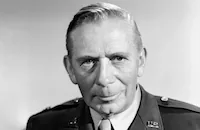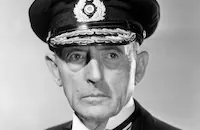The Hitler Gang
Brief Synopsis
Cast & Crew
John Farrow
Robert Watson
Roman Bohnen
Martin Kosleck
Victor Varconi
Luis Van Rooten
Film Details
Technical Specs

Synopsis
In Nov 1918, after Austrian-born lance corporal Adolf Hitler is admitted to a hospital due to temporary blindness, a doctor determines that his condition is due to severe emotional problems and paranoia rather than a war injury. Hitler is released just as Germany loses the war, and when he later overhears several soldiers discussing the overthrow of the new military government, he reports the men to Captain Ernst Roehm, and becomes a paid military informant. Roehm orders Hitler to join the German Workers party, and Hitler takes control of the party, luring in new members such as politician Gregor Strasser, his chauffeur, Heinrich Himmler, and Rudolf Hess, with his powerful speeches. Seeking a scapegoat for Germany's severe postwar economic problems, Hitler targets the Jewish population. When other members of the Party oppose Hitler's bigotry, Hitler orders Himmler to keep a record of his detractors. In addition, Hitler brings in former air force captain Hermann Goering to provide protection for the Party in exchange for appointing Goering head of the air force when they take over the government. In 1920, the Party, known as the National Socialist German Workers, or Nazis, has only sixty-four members, but by 1923, Hitler's leadership has caused the membership to swell to 70,000 people. The now powerful Nazis use brutality to suppress any opposition to their ideas. Fearful of Hitler's new influence, the government bans his meetings, but when Hitler promises to take no action against the government, Bavarian state commissioner General Gustav von Kahr agrees to lift the ban. However, on 8 November 1923, Hitler disrupts von Kahr's meeting at a beer hall and announces his overthrow of the government. The next day, General Erich Ludendorff marches with Hitler's troops through the city, but von Kahr's army attacks the Nazis, and Hitler and his followers are arrested. Although the chief prosecutor wants Hitler and his followers executed, the chief justice advises extreme leniency due to the possibility of Hitler revealing those members of the German army who initially supported him. Hitler and his followers are therefore sentenced to prison, but Goering escapes to Austria and is admitted into a sanitarium for treatment of his morphine addiction. During his term at Landsberg Prison, Hitler dictates his autobiography, titled Mein Kampf , and becomes influenced by astrology. In the spring of 1924, Joseph Goebbels, the Berlin district leader of the Nazi party, visits Hitler and pledges his allegiance. By December 1924, when Hitler is released, Germany is experiencing prosperity. Based on his astrologer's advice to lay low for five years, Hitler moves to a Bavarian mountain cottage with his sister, Angela Raubal, and her daughter "Geli." When Hitler becomes obsessed with Geli and loses sight of his political goals, Himmler, Hess and Goering, who has returned despite reports of his insanity, worry that Hitler may lose the Party to Strasser, who has become head of the Party's northern territory. After Hitler forces himself on Geli, Himmler, hoping to make Hitler jealous, arranges for him to catch Geli with a handsome young Nazi officer. Hitler murders Geli and her death is ruled a suicide, as the only reporter who found evidence to the contrary is murdered by Hitler's men. By 1930, Germany has slumped into a severe economic depression, and Hitler is determined to attain power legally. Hitler now tailors his speeches to suit his audience, and the Nazi party jumps from the smallest party to the second largest party in Germany. Nevertheless, Paul von Hindenburg defeats Hitler and is re-elected as president of the Weimar Republic. Although his goals differ from Hitler, von Hindenburg reluctantly appoints him to be the Reichschancellor, intending to get rid of him in six months. Instead, Hess and Goering engineer a Communist scare to rally support behind the Nazi party, and frame the Communists for burning down the Reichstag. Hitler then uses von Hindenburg's decree limiting personal liberties to wage a systematic campaign against all who oppose the Nazis, including Jews, Communists, newspapers and trade unions. The education system comes under Nazi control, and the nation's youth are indoctrinated to believe in Germanic principles, as opposed to Christian principles. Although the military leaders promise to appoint Hitler as Supreme Commander when the elderly von Hindenburg dies, they demand that Hitler's Storm Troopers, who are under Goering's command and were created to protect the Nazis, be dissolved. Roehm is ordered to lure Hitler and the Storm Troopers into a trap at Weissensee, but Himmler, Hess and Goering, seeing that Hitler is mentally unstable, insist that he take action to "cleanse" the Party. To this end, Hitler is sent to the mountains while Himmler and Goering create lengthy lists of their detractors, and those whom they simply dislike, from which they wage a campaign of murder, killing thousands over the course of four days. Roehm, Strasser and von Kahr are among those killed. When von Hindenburg dies, Hitler takes control of the army, and proceeds with his plan to exterminate the Jews and take over the world.

Director

John Farrow
Cast
Robert Watson

Roman Bohnen
Martin Kosleck
Victor Varconi
Luis Van Rooten
Alexander Pope
Ivan Triesault
Poldy Dur
Helene Thimig
Reinhold Schunzel

Sig Ruman

Alexander Granach
Fritz Kortner
Tonio Selwart
Richard Ryen

Ray Collins
Ludwig Donath
Erno Verebes

Walter Kingsford
Fred Nurney
Arthur Loft
Lionel Royce
Paul Decorday
Gene Stutenroth

Frank Reicher
Harry Hays Morgan
Peter Pohlenz
Norman Lempert
Frank Alten
George Sorel
Richard Mullen
Mike Lally
Philip Van Zandt

Kurt Kreuger
Felix Basch
Stanley Andrews

Walter Abel

Albert Dekker

Harro Meller
Lotte Palfi
Rudolph Anders
Fred Giermann
Hermine Sterler
Egon Brecher

Hans Von Twardowski
John Mylong
Rex Williams
George Sorel
Louis Arco
William Vaughn
Henry Guttman
Geza Remy
Bernard Sommer
Betty Farrington
John Sheehan

Howard Mitchell
Adolph Milar
Stuart Holmes
Walter Fenner
Major Sam Harris
Carl Leviness
Pamela Drake
Jack Deery
J. W. Johnston
James Carlisle
Sigurd Tor
Roy Brent
Otto Reichow
George Lynn
Paul H. Salzburg
Neil Carter
Milton Parsons
George Sherwood
Robert R. Stephenson
William Yetter Jr.
Dale Cornell
David King
Pete Fogel
Boots Brown
Peggy Mcintyre
Eleanor Taylor
William Yetter Sr.
Ernest Golm
Pamela Drake
Janna Deloos
Lisa Golm
Crane Whitley
Hella Crossley
Paul Weigel
Gene Reading
Stephen Wayne
Vincent Gironda
Robert Ashley
Rube Schaffer
Verne Anders
Dave Kahner

Freddie Steele
Crew
Rudolph Anders
Franz Bachelin
David Buttolph
Sam Comer
B. G. Desylva
Mary Kay Dodson
Hans Dreier
Alvin Ganzer
Frances Goodrich
Bertram Granger
Albert Hackett
Joy Harrington
Don Johnson
N. Lacey
Ernest Laszlo
Donald Mckay
K. Neumann
Helen Gladys Percey
Peter Pohlenz
Hermann Rauschning
Hermann Rauschning
Leonora Sabine
Lester Sharpe
Joseph Sistrom
Eda Warren
Wally Westmore
Charles Woolstenhulme
Joseph Youngerman

Film Details
Technical Specs

Quotes
Gerlich has shot himself.- Rvhm
He's the first man who shot himself in the head six times.- Streicher
Trivia
Notes
The film's opening credits consist of the main title and the following written foreword: "In 1918 the Germans, facing annihilation, surrendered to the Allies. But there were men among them who did not acknowledge defeat. Before the last shot was fired, they were already planning for the next world war. This is the story of those men. Shocking though it May be, it is based on fact. The episodes throughout are authenticated by documentary records, by the works of reputable historians, and in some instances by actual participants. In every detail it is true insofar as decency will permit." All other production credits appear at the end of the film.
Paramount billed The Hitler Gang as a "documentary-propaganda" film, and while the historical record reflects that the picture's depiction of Hitler's rise to power is presented with reasonable accuracy, various inaccuracies and interpretations May also be included. During his campaign of conquest in World War II, Hitler ordered the methodical massacre of over six million Jews and other political enemies. He committed suicide in 1945 when the Russians invaded Berlin, and Germany faced defeat. Twenty-four of his surviving associates, in addition to various organizations, were indicted as war criminals by the International Military Tribunal.
New York Times film critic Bosley Crowther, noted that the "film is of questionable worth as a document for mass instruction in the political facts of Germany. For the emphasis in this picture is so heavily upon the 'Hitler gang' and upon the inside intrigues by which it gained and held its power, that the impression conveyed is that these leaders are entirely responsible for the Nazi state....'The Hitler Gang' is cut very much to the pattern of some of our early and better gangster films....Paramount has taken a popular though misleading line in treating National Socialism in the elementary terms of an American gang. It means that the grave responsibility of the German citizens for what they have allowed has been neatly tossed onto the shoulders of a few ruffians, Army officers and industrialists." Crowther concluded that the film "is a dangerously limited statement of the facts." Likewise, the Catholic newspaper Tidings complained that the film suggests that "Hitler's wrath against the Jews originated in political expediency and that he might as easily and readily have begun a war of extermination against the Catholics," and also noted that "Hitler's alleged designs upon his young niece....would seem difficult if not impossible, to prove."
According to information in the Paramount Collection at the AMPAS Library, pre-production began in March 1943, during which time extensive research was conducted to provide factual documentation for the film. Other information in the collection reveals that Claude Rains was considered for the role of Adolf Hitler, and that Kurt Kreuger was originally cast as Reinhard Heydrich. Hollywood Reporter news items add the following information about the production: Alexander Knox and Orson Welles were tested for the role of Hitler, Albert Basserman was considered for the role of Paul von Hindenburg, and Porter Hall was initially cast as Heinrich Himmler. Paramount utilized contemporary newsreel footage, some of which May have been drawn from the Museum of Modern Art collection, for specific historical scenes in this film. Paramount News items noted that the studio purchased two rooms from the New York Hearst Collection to use as industrialist Alfred Hugenberg's library, and that a large painting depicting the glories of Prussianism was designed for the film by Franz Bachelin, and painted by artists Benno Prival and P. T. Blackburn. Some scenes were shot at Warner Bros. studios, at the Los Angeles YMCA, and on location in Elysian Park and the Shrine Auditorium in Los Angeles, CA. Variety lists the running time as 101 minutes, but this length is probably an error.












